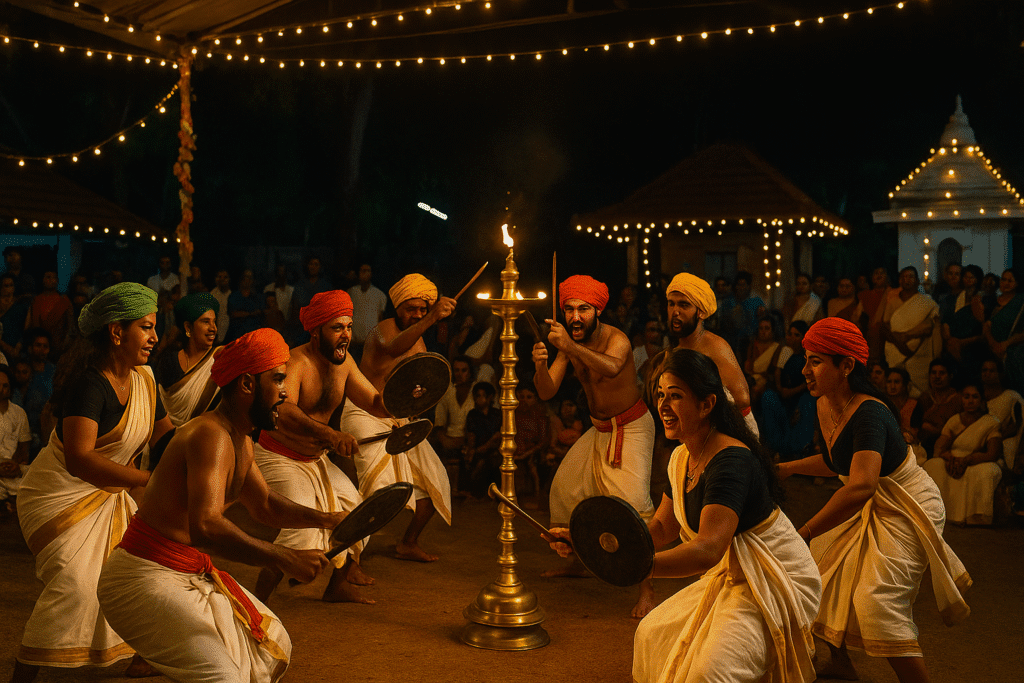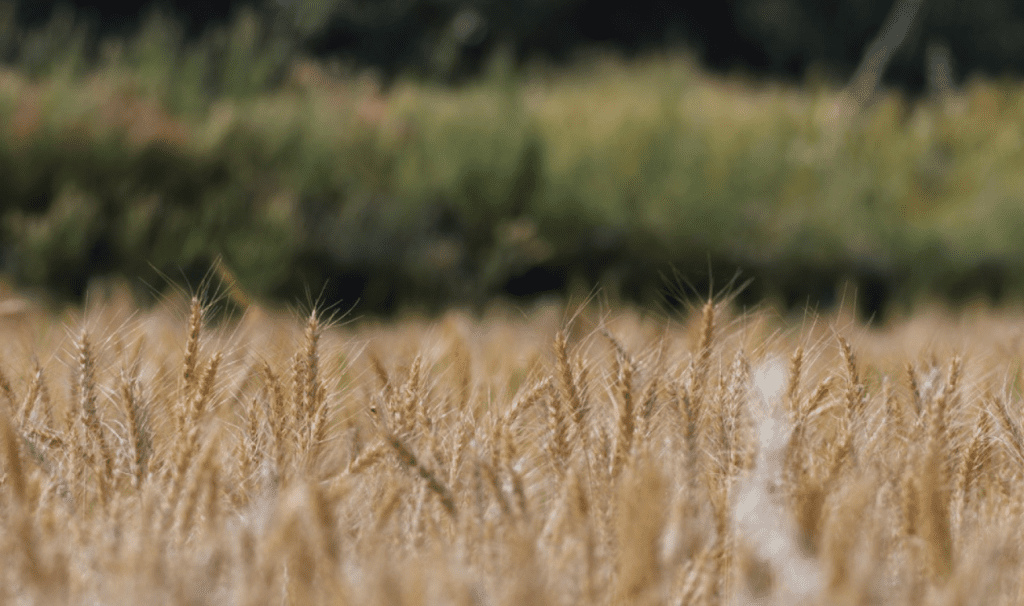Introduction
Kanyarkali, a dynamic folk dance ritual also known as Desathukali or Malamakkali, is a cultural gem of Kerala’s Palakkad district, performed primarily by the Nair community. Celebrated during March and April, particularly around Vishu, this festival blends martial arts, rhythmic dance, and comedic storytelling in honor of Goddess Bhagavathy or Vettakkorumakan. Held in Kurumba Bhagavathy temples and village tharas (informal gathering spaces), Kanyarkali is a four-night spectacle of devotion, heritage, and community spirit. This article explores the festival’s origins, rituals, and evolving role in preserving Palakkad’s cultural identity, offering a fresh perspective on its enduring appeal.
Historical and Cultural Roots of Kanyarkali
Origins in Martial Traditions
Kanyarkali traces its roots to the medieval period when Palakkad faced threats from neighboring Konganadu. To prepare for defense, Nair men honed martial arts, particularly Kalaripayattu. To infuse vigor and camaraderie into these training sessions, dance and comedy were incorporated, giving birth to Kanyarkali. Over time, this blend evolved into a ritualistic performance offered to Goddess Bhagavathy, believed to bring prosperity and protection to villages. The festival’s name, possibly derived from Kannakiyammankali (linked to the Tamil epic Silappatikaram’s Kannaki), reflects its narrative depth, though it is distinct from the Kannaki cult.
A Pillar of Nair Heritage
Kanyarkali is a cultural cornerstone for the Nair community in Alathur and Chittur taluks, performed across 35 desams (village clusters) like Kakkayur, Nemmara, and Koduvayur. Despite its Nair origins, the festival fosters inclusivity, with participation from other communities in roles like musicians or spectators. Its songs, sung in Tamil and Malayalam, depict the lives of Malayalam communities—once slaves or dependents of feudal lords—shedding light on historical social structures. Kanyarkali’s over 700-year-old legacy underscores its resilience amid changing times.
Spiritual and Social Significance
A Devotional Offering
Kanyarkali is a ritualistic offering to Goddess Bhagavathy or Vettakkorumakan (the hunter form of Lord Shastha), performed to seek divine blessings for agricultural prosperity and community well-being. The festival aligns with Vishu, the Malayalam New Year (April 14 or 15), marking the start of the agricultural cycle. Performed on a pandal (square stage) with a nilavilakku (traditional lamp) at its center, the dance embodies devotion, with rhythmic movements and devotional songs invoking divine protection.
Fostering Community Unity
Kanyarkali strengthens social bonds in Palakkad’s villages. The four-night performances, preceded by Karivela and Vattakali rituals, draw families and neighbors together, creating a festive atmosphere. The comedic Purattu sequences, depicting everyday life or historical anecdotes, resonate with audiences, fostering shared laughter and cultural pride. The festival’s inclusivity—evident in recent participation by women and other communities—reflects its adaptability and role as a unifying force in a diverse region.
Rituals and Traditions of Kanyarkali
Preparations and Initiation
Preparations for Kanyarkali begin a month in advance with Kadikumbidal, a ritual initiating rigorous training under a Kaliyachan (master performer). Performers, typically 6 to 20 men, practice 64 chuvadukal (steps), though only 20–25 are used in performances. The festival starts with Kaniyar Kollal on the Tuesday after Vishu, followed by Kelikottu, a ceremonial drumming announcing the event. The Nadavattom ritual marks the performers’ entry onto the pandal, setting the stage for the nightly dances.
The Four-Night Spectacle
Kanyarkali unfolds over four nights (or three in some villages), each with a distinct name and style:
- Iravakali (Night 1): A ritualistic performance with synchronized footwork and martial movements.
- Anadikoothu (Night 2): Features comedic Purattu skits, often portraying village life or historical tales.
- Vallon (Night 3): Includes slower, rhythmic dances with storytelling elements.
- Malama (Night 4): Showcases hill tribe performances, with women participating in recent years, and over 40 unique steps, concluding with fireworks and dramatic Porattu scenes.
Performers, dressed in kasavu mundu (gold-bordered dhotis) and turbans, move in circular patterns around singers, accompanied by instruments like chenda, maddalam, edakka, udukku, ilathalam, chengila, and kurumkuzhal. The Vattakali, a rhythmic circular dance, opens each night, followed by Purattu farces that blend humor and social commentary.
Cultural Performances and Symbolism
Kanyarkali’s dances combine martial agility with folk grace, reflecting Palakkad’s historical need for defense. The Porattu style, with its humorous skits like reunions of long-lost couples, contrasts with the ritualistic Vattakali, showcasing the festival’s versatility. Songs narrate tales of feudal relationships or legends like Kannaki, adding depth to the performances. The vibrant costumes and loud percussion create an electrifying atmosphere, symbolizing community strength and devotion.
Kanyarkali in Palakkad and Beyond
Celebrations in Palakkad
Kanyarkali is a highlight in Palakkad’s cultural calendar, performed in villages like Manjalur, Pallassena, and Kuniss активностиery. Major venues include Kurumba Bhagavathy temples and Vettakkorumakan temples, with performances succeeding the Vela (village fair). The Nemmara Vallanghy Vela, held in March or April, features Kanyarkali alongside folk rituals like Kummatti and Karivela, drawing large crowds. The festival’s fortnight-long celebrations, including caparisoned elephant processions and fireworks, make it a spectacle of regional pride.
Global and Diaspora Reach
Kanyarkali has transcended Palakkad’s borders, with performances in Sharjah (2019) and among Kerala’s diaspora in cities like Mumbai and Dubai. These events, often organized by cultural groups, feature traditional dances and music, preserving the art form for younger generations. Social media and YouTube videos, like those by Vinod Vadassery Productions, have globalized Kanyarkali, showcasing its vibrant steps to international audiences.
Modern Adaptations and Challenges
Breaking Gender and Caste Barriers
Traditionally an all-male Nair performance, Kanyarkali has seen progressive changes. In 2010, girls joined the singing group at Kakkayur, and in the last decade, women performed in a Desappanthal at Kakkayur, marking a historic shift. Non-Nair communities have also begun participating, challenging caste boundaries. However, cultural activist Vasudevan notes resistance to these changes, as age-old traditions are hard to break. Encouraging broader participation remains a work in progress.
Preserving Heritage Amid Modernization
The decline of agrarian culture and youth migration to urban jobs threaten Kanyarkali’s survival, as noted in T. Sreevatsan’s documentary Kanyarkali: Arangum Anushtanavum. The art form’s lack of formal scriptures, relying on oral transmission, adds to preservation challenges. Cultural organizations and performers like Dwaraka Krishnan, honored by the Kerala Sangeetha Nataka Akademi, are working to document and promote Kanyarkali through workshops and festivals. Integrating it into school curricula could attract younger performers.
Lessons from Kanyarkali for Today
Resilience and Adaptability
Kanyarkali’s evolution from martial training to a cultural ritual reflects resilience, offering lessons in adapting traditions to modern contexts. Its ability to incorporate humor and social commentary ensures relevance, inspiring communities to preserve heritage while embracing change. The festival’s communal spirit encourages collective action in addressing contemporary challenges.
Cultural Expression and Unity
Kanyarkali’s blend of dance, drama, and music celebrates Palakkad’s diverse history, fostering unity across communities. Its inclusive evolution—welcoming women and other castes—mirrors the need for equitable societies. By resonating with everyday life, as performer Vasudevan notes, Kanyarkali teaches the power of art to reflect and shape social values.
Kanyarkali and Cultural Tourism
Kanyarkali’s vibrant performances and historical depth make it a potential tourism draw. Visitors to Palakkad can witness the festival at temples like Pookulangara Bhagavathy or during the Nemmara Vallanghy Vela, experiencing authentic Kerala culture. Promoting Kanyarkali through Kerala Tourism’s platforms, alongside events like the Konark Festival, could boost local economies and global awareness of Palakkad’s heritage.
Conclusion
Kanyarkali is a pulsating celebration of Palakkad’s Nair heritage, weaving martial prowess, devotional dance, and comedic storytelling into a cultural masterpiece. From its origins in defense against Konganadu to its modern inclusivity, the festival embodies resilience, devotion, and community spirit. As it navigates challenges like urbanization and tradition’s rigidity, Kanyarkali remains a vibrant testament to Kerala’s cultural richness. Let us honor this folk art by supporting its performers, documenting its legacy, and celebrating its universal message of unity and creativity.



